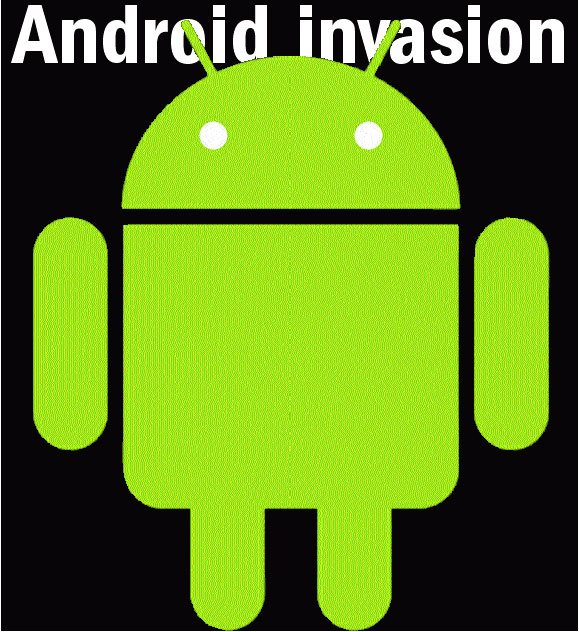The country is in the midst of an Android invasion, and there’s
no sign of it slowing down.
The country is in the midst of an Android invasion, and there’s no sign of it slowing down.
Since late April, more than a dozen new smart phones – most of them running Google’s Android operating system – have hit stores. Apple’s iPhone 4 with service on AT&T has grabbed the most media buzz of all the new smart phones, with customers still occasionally finding some stores out of stock. But competitor phones with Android systems have also flown out of stores, including Verizon’s Droid Incredible and Droid X, Sprint’s Evo and Epic, T-Mobile’s HD2 and Vibrant, and AT&T’s Captivate.
Throw in the launch of a new touch-screen BlackBerry, and 2010 has shaped up as an unprecedented bonanza for consumers and smart-phone makers.
“I think the appetite for smart phones has exceeded what we expected,” said Verizon spokesman Chuck Hamby.
This year, more Android phones are on the market boasting iPhone-like features, and some with hardware that the iPhone lacks, like slide-out keyboards, higher-megapixel cameras or the ability to act as a mobile Wi-Fi hotspot for other devices.
The result: Consumers are buying Android phones at a faster pace than iPhones.
Android phones accounted for 33 percent of all smart phones purchased in the United States in the second quarter of 2010, ahead of BlackBerry’s RIM with 28 percent and Apple’s iPhone with 22 percent of the market, according to research company NPD Group.
One of every three smart phones sold at retail stores is equipped with an Android system, NPD reported. In August, Google’s CEO Eric Schmidt reported about 200,000 Android devices were sold a day – double from two previous months.
Driving that popularity is the sheer number of Android phones with top-of-the-line hardware.
Every few weeks since the end of April, a new smart phone has been introduced amid a flurry of advertising. AT&T and Verizon each offered four powerful, app-filled smart phones. Sprint and T-Mobile each introduced two phones – and have more on the way.
“One phone is not for everyone,” Hamby said. “Not everyone wants the (Droid) Incredible, even though it seemed that way. Not everyone wants the (Droid) X, even though it seems that way. The strategy is to offer something for everyone.”
But the seemingly endless stream of new choices can be aggravating – especially to status-conscious consumers.
“You buy a cell phone and you get locked into a two-year contract, and two months later it’s superseded by a better one,” said Andrew Eisner, director of community and content for consumer electronics review and research website Retrevo.com. “It can be very frustrating for the consumer.”
And confusing as well. While iPhone 4 offers a single interface, each Android interface varies with the phone model. Android phones built by HTC have different home screen tools – called widgets – than Motorola’s or Samsung’s Android phones. Some phones have different menu controls than others, or offer different pre-installed applications.
For example, Verizon’s Samsung Galaxy S Fascinate is the only Samsung Galaxy S phone that currently comes pre-programmed with Microsoft Bing search widgets instead of Google search widgets.
Network speed also has played heavily in purchasing choices. For the first time, phones are being crafted to run at faster-than-3G data speeds. Sprint has two phones – Evo and Epic – that run on its new 4G network. Yet 4G – touted to run up to 10 times faster than the current 3G network – isn’t yet widely available.
Hardware is the other battleground, where anything less than a 1GHz processor is sluggish, a camera without a flash is sub-par, and turning the phone into a mobile Wi-Fi hotspot is an increasingly common luxury.
The ability to view websites that use Adobe Flash to show animations and video can sway a heavy Web user to go with Android, since Apple’s iPhone hasn’t supported Flash programming.
Bigger-is-better is another selling point. Both Verizon’s Motorola Droid X and Sprint’s Evo have a 4.3-inch screen, versus the iPhone 4’s 3.5-inch screen. And Samsung’s Galaxy S line all have 4-inch screens.
But the big hardware trend this season is two cameras – one on back, a second on the front near the screen – for two-way video chatting.
The iPhone 4 has it, and so do two of Sprint’s phones: the HTC Evo 4G and Samsung Epic 4G. For now, the technology is in an adolescent stage. iPhone 4 users can only video chat with other iPhone 4 users who are using a Wi-Fi connection to connect to the Internet (to avoid putting a burden on AT&T’s 3G wireless network). And with Sprint’s phones, they require downloading a third-party application, like Qik or Fring.
Retrevo’s Eisner said he thought he’d use video chatting more often with his Evo, but “It’s kind of a hassle. It’s just easier to make a phone call.”
Whether you pick an iPhone, a BlackBerry or a handset with an Android operating system, you will likely stick with it for some time. Apps bought on the iPhone won’t work on Android or BlackBerry, and vice versa – making it less appealing to jump ship after two years. And now that more gadgets like tablet computers are using these specialized mini-programs, expect loyalty toward the operating system that holds your apps.
How to pick the perfect smart phone
In the past few months we’ve seen more than a dozen new high-quality smart phones with powerful hardware – and tested them.
So which should you buy? First, decide which service provider you want to use. Not every phone is available from every carrier, and costs for monthly plans can vary significantly. Most phones cost about $200, after rebates and two-year contracts.
That said, software changes quickly, and the carriers are constantly coming out with software upgrades users can download to fix bugs and add features.
But for now, these are the winners in my book:
– Larger-than-average screen: HTC Evo 4G on Sprint. Compared to its larger brethren, it’s got the best interface and a second camera on the front for video chatting.
– Slide-out keyboard: Top-of-the-line choices are AT&T BlackBerry Torch, Verizon Droid 2 and Sprint’s Samsung Epic 4G. My pick: Epic for its sharp graphics, spacious keyboard layout, quick and smooth response. It also has an extra camera on the front if you want to video-chat.
– Photo-video sharing: The iPhone 4 and HTC’s Aria (both AT&T), Evo (Sprint) and Incredible (Verizon). Others new this season, such as the Samsung Galaxy S line of Androids (available on all major carriers), have great cameras, but current software forces all vertical photos to be shared horizontally.
– Video watching: It’s a toss-up between the iPhone 4 and the Samsung Galaxy S line of Android phones. The iPhone 4 offers Netflix (coming soon to Android), and Android has a Blockbuster app for instantly downloading movies. The Galaxy S is soon to feature a Media Hub – which is like an iTunes for Samsung.
– Video chats: Three phones – AT&T’s iPhone 4, and Sprint’s HTC Evo 4G and Samsung Epic 4G – have front-facing cameras that allow video chatting. It’s easiest on the iPhone, but as of now, you can only chat with other iPhone 4 users using Wi-Fi. The video chat apps for the Evo and Epic can use improvement, but they have more flexibility on whom you can chat with and where you can chat.
– Mostly business: Any of the latest smart phones can sync Outlook e-mail and calendar. Still, the new BlackBerry Torch is especially popular with businesspeople who are addicted to its messaging interface, keyboard with raised keys and blinking red alert light – though it offers limited multimedia functions and few apps.















